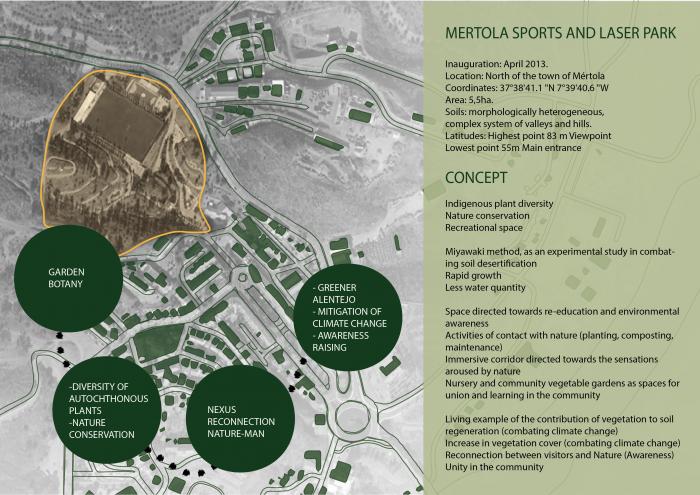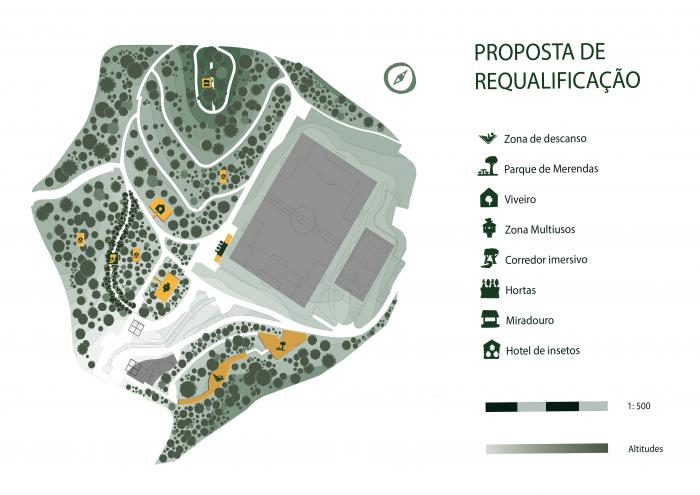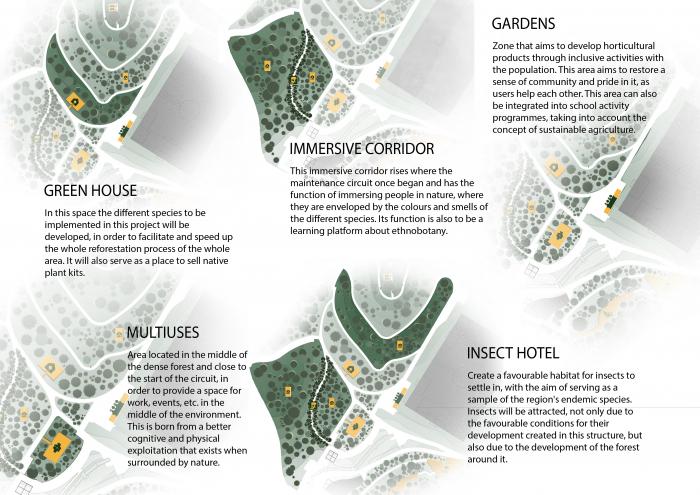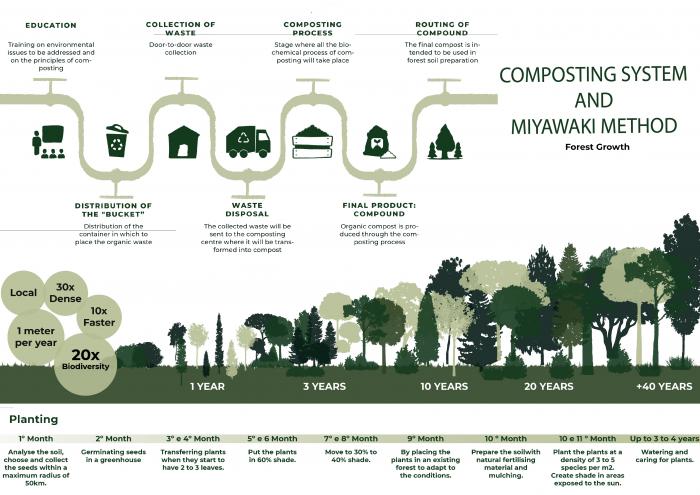A Botanical Garden in a village in Baixo Alentejo, Portugal? Yes! Why? Because villages like Mértola are the most affected by climate change. A Botanical Garden in Mértola is not only for this village, but for all the cities, towns and villages far from the big centres that suffer with the aridity of the soil, with the intense heat and the lack of water. The First Botanical Garden in Europe built using the Miyawaki method for monitoring and recording, in a place where the difficulty of planting.
When soils desertify, human life also succumbs to the lack of hope, of a future. Human life dries up with the soil in a perverse symbiotic process. And it is this deep connection, so often forgotten, of the human being to his ecosystem that impels us to propose a holistic approach to the problem of desertification and discouragement of the municipality of Mértola.
From the perspective of sustainable development in the municipality of Mértola, we propose the requalification of Mértola's sports and leisure park. We intend to give it a new life, benefiting from what characterizes it and its surroundings. We focus on space as a biophilic medium for re-education and awareness-raising, for the relationship of people with trees, and of the individual as an integral part of the ecosystem. By restoring existing forest areas using the miyawaki method, it will be possible to regenerate the soil with an emphasis on indigenous flora.
This will promote the region's natural culture to both local and foreign visitors. Consequently, we have planned a project that will bear fruit for the mitigation of climate change, achieving a greener Alentejo with more biodiversity.
Please highlight how the concept/idea can be exemplary in this context
The systems map of this project is a circular map, since its action is based on the circular economy, which, as the Ellen MacArthur Foundation defines it, is "an economy that is restorative and regenerative by design". And that is exactly what is intended with the community project, in question, with this one aims at a human development interconnected with nature.
The circular economy is an important factor in this process, because it can be used to address environmental, social and economic challenges. Environmental education and the composting system are ways to reach the Miyawaki forest creation. These two actions have a social aspect that promotes human development, through social integration, sense of community and sharing of a common goal. Strengthening human and environmental bonds and relationships. Circular economy can also be used as an economic factor, as from these forests may give rise to products that help economically help Mértola. Whether it's the sale of a type of kit with autochthonous flora such as a Mertolense testimony, that whoever buys can one day come back later and plant their tree in a Miyawaki tree in a Miyawaki Forest, promoting and environmentally conscious tourism. correct tourism. Whether in the distribution or sale of this kit to the population itself so that people with space can contribute to the fight against climate change. Or even the compost from community composting compost can be an exchange currency or a saleable saleable product
Please highlight how the concept/idea can be exemplary in this context
The Botanical Garden of Mértola is an experimental and experiential space where we want the senses to be awakened to a more tolerant experience with trees and their entire process, is also an attempt to rescue an imagetic memory of an Alentejo secularly forgotten by much of the population.
Landscape, product, communication and systems design strengthen the symbiosis behind what is the Botanical Garden of Mértola.
The visual identity of Mértola's Botanical Garden is inspired by the altitudes and textures that tell the story of what could become the cover for raising awareness of the municipality's notorious climate change but also an open house for the whole community.
Please highlight how the concept/idea can be exemplary in this context
By contextualizing local realities in a multidisciplinary way, it will be possible to better understand the concepts by the individuals involved in the actions. We also understand that knowledge can often be easier to pass on when children are the link. As they bring school experiences to the family context, they inspire the community that surrounds them. The implementation of a project within the approached theme may not only involve children, but also the entire young, adult and elderly community, emphasizing the importance of human relationships with nature.
From a social point of view, the development of this project leads to unity among the resident community, as they strengthen the relationships among everyone due to the mutual help needed for the project to unfold. The community has also developed environmental awareness, important in the perception of the change needed to effectively combat climate change and a more sustainable way of life. Soil regeneration allows the creation not only of forests but also agro-forests that can boost local economies.
An approach to raising awareness of environmental and social issues may also be feasible through the dynamics of knowledge sharing, such as workshops and awareness-raising activities, something that is not imperative, but rather cooperative.
Please highlight how this approach can be exemplary
We begin this projectual journey with the urgency of looking at the soils and the social, as an undeniable and unavoidable union on what could resemble a real solution for Mértola. Of the dry and tired soils, where the water insists on draining away to a place where it can't be used. Like a rejection of the life that could sprout from the land. But we stubbornly, because life is often made by stubbornness. We believe that in the soil-social dynamic it is a seed that unites them, in fact several seeds.
The adaptation of the Miyawaki method to Mértola enables the planting of a dense and regenerative forest. But above all, it provides the place where this method can be studied, analysed and improved so that it can be a real tool to combat desertification. The municipality of Mértola has become a living laboratory for universities from all over the world, a hub for exploration and methodologies that aim to respond to a southern Europe in the process of desertification. If on one hand we embrace academic paradigms, on the other hand we want to include all the population, the ones we talk to, who honour the trees of their land, those species that all the jokes from Alentejo are about. And as a simple but effective anecdote, there are so many layers to these relationships, and what we take from a distant relationship with the trees, is also a relationship of pride. And if on the one hand there is the concern for the cleanliness of the environment, on the other there is the rejection of flora other than that which is already perceived as autochthonous. It is in this ambiguous relationship with the trees that we want to act, in this space of communication that these actions are proposed.
A step-by-step with the hope of involving the community in a garden, which will be theirs and belongs to all those who visit and enjoy this space. Bringing back to Mértola the meeting point of ideas and debates, where in the same church several religions cohabited, as archaeologis
Use of the miyawaki method as a reforestation method - The Miyawaki method consists in planning the reforestation of a forest, using exclusively indigenous plants, these being planted randomly and densely. This method has been applied in all continents with encouraging results, many studies have been done where the effectiveness of the method is proven. In 2011, I came out in Landscape and Ecological Engineering the result of an Italian study, done over 10 years, on the application of this method in Mediterranean areas affected by increasing desertification. The study looked at four plots of land, two with traditional reforestation, the other two with reforestation according to the Miyawaki method, with changes to better adapt to the environmental conditions. The result of this study was highly encouraging even without the three years of maintenance that are usually done. This leads us to believe that this type of forest could be a viable solution for Mértola in both urban and rural areas.
Connection of people with the ecosystem - By contextualizing local realities in a multidisciplinary way, it will be possible a better understanding of the concepts by the individuals involved in the actions. We also understand that knowledge may often be easier to pass on when children are the link. As they bring school experiences to the family context, they inspire the community that surrounds them. The implementation of a project within the approached theme may not only involve children, but also the entire young, adult and elderly community, emphasising the importance of human relationships with nature.
Strengthen mutual help in the community - By implementing an approach to raising awareness of environmental and social issues through the dynamics of knowledge sharing, we will encourage cooperation between communities in the development of the activities proposed in this project.
This project is based on a timeline that begins with the creation of a composting system to facilitate soil preparation, followed by a second phase of planting dense forest areas using the miyawaki method and a third phase of requalification of the pdlm area. Requalification is understood as the creation of new recreational and leisure areas related to culture and knowledge, the elaboration of interactions based on the relationship of the community with nature and the recovery of inactive areas.
In order to be able to implement this project, funding will be required. To this end, a search was made for funds and competitions for which the Botanical Garden of Mértola could be a potential choice.
Winning this award would be extremely important for us, not only in terms of our curriculum, as it would open many doors at our career level, but mainly to make our dream of being part of the change for a better world come true.
With this, we aim to continue to create projects for sustainable development at local, regional and who knows, one day, worldwide. For us, it is significant to take advantage of the different valences and skills of each person in our team. Our knowledge-sharing has inspired us to promote the impact we have all together because the future is collaborative.
@Santos, 2022
Content licensed to the European Union.





